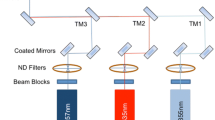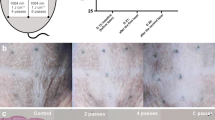Abstract
The aim of this study was to investigate the effects of the different types of low-level laser therapy (LLLT) on the ultra-structure and number of melanosomes in normal cultured human melanocytes. Specific effects of various types of LLLT on the ultra-structure of melanosomes have not yet been reported. Melanocytes were exposed to LLLT at an energy level of 2.0 J/cm2, using a blue (457 nm), red (635 nm), or ultraviolet (UV) (355 nm) laser. After 72 h of irradiation, the melanocytes were fixed in 2.5 % glutaraldehyde (pH 7.2) phosphate buffer for 8 h and analyzed by transmission electron microscopy. Four developmental stages (I to IV) of melanosomes were observed, and their numbers were counted manually. The percentage of stages I, II, III, and IV melanosomes was 12.8, 14.2, 22.6, and 50.3 %, respectively, in the control (sham light). However, the melanosome percentages were 41.2, 5.4, 8.2, and 24.2 % in stages I, II, III, and IV, respectively, in the blue laser-treated group; 58.4, 6.1, 9.3, and 26.2 % for stages I, II, III, and IV, respectively, in the red laser-treated group; and 31.3, 11.1, 16.5, and 41.1 % for stages I, II, III, and IV, respectively, in the UV laser-treated group. The present data show that the amount of stage I is significantly higher (P < 0.0001) in the LLLT-treated cells compared to the control, which indicates significant stimulation of melanogenesis. The red laser was more effective than the other lasers. Moreover, the effects of LLLT on the ultra-structure of melanosomes need to be studied in a larger number of subject groups.


Similar content being viewed by others
References
Pawelek JM, Korner AM (1987) The biosynthesis mammalian melanin. Am Sci 70:136–145
Yu HS, Wu CS, Yu CL, Kao YH, Chiou (2003) MH Helium-neon laser irradiation stimulates migration and proliferation in melanocytes and induces repigmentation in segmental-type vitiligo. J Invest Dermatol 120:56–64
Alghamdi KM, Kumar A, Moussa NA (2012) Low-level laser therapy: a useful technique for enhancing the proliferation of various cultured cells. Lasers Med Sci 27(1):237–279
AlGhamdi KM, Kumar A, Ashour AE, AlGhamdi AA (2015) A comparative study of the effects of different low-level lasers on the proliferation, viability, and migration of human melanocytes in vitro. Lasers Med Sci 30(5):1541–1551
Gasparyan VC (2000) Method of determination of aortic valve parameters for its reconstruction with autopericardium: an experimental study. J Thorac Cardiovasc Surg 119:386–387
Tuby H, Maltz L, Oron U (2007) Low-level laser irradiation (LLLI) promotes proliferation of mesenchymal and cardiac stem cells in culture. Lasers Surg Med 39:373–378
Yamaguchi Y, Hearing VJ (2009) Physiological factors that regulate skin pigmentation. Biofactors 35(2):193–199
Birbeck MSC (1963) Electron microscopy of melanocytes, fine structure of hair bulb premelanosomes. Ann N Y Acad Sci 100:540–547
Seiji M, Fitzpatrick TB, Birbeck MSC (1961) The melanosome: a distinctive subcellular particle of mammalian melanocytes and the site of melanogenesis. J Invest Dermatol 36:243–252
Seji M, Fitzpatrick TB, Simpson RT, Birbeck MSC (1963) Chemical composition and terminology of specialized organelles (melanosomes and melanin granules) in mammalian melanocytes. Nature 197:1082–1084
DuBuy HG, Showacre JL, Hesselbach ML (1963) Enzymic and other similarities of melanoma granules and mitochondria. Ann NY Acad Sci 100:569–583
Lerner AB, Halaban R, Klaus SN et al (1987) Transplantation of human melanocytes. J Invest Dermatol 89:219–224
Eduardo Fde P, Bueno DF, de Freitas PM et al (2008) Stem cell proliferation under low intensity laser irradiation: a preliminary study. Lasers Surg Med 40(6):433–438
Hou JF, Zhang H, Yuan X et al (2008) In vitro effects of low-level laser irradiation for bone marrow mesenchymal stem cells: proliferation, growth factors secretion and myogenic differentiation. Lasers Surg Med 40(10):726–733
Mvula B, Mathope T, Moore T et al (2008) The effect of low level laser irradiation on adult human adipose derived stem cells. Lasers Med Sci 23(3):277–282
Kim HK, Kim JH, Abbas AA et al (2009) Red light of 647 nm enhances osteogenic differentiation in mesenchymal stem cells. Lasers Med Sci 24(2):214–222
Lan CC, Wu CS, Chiou MH et al (2009) Low-energy helium-neon laser induces melanocyte proliferation via interaction with type IV collagen: visible light as a therapeutic option for vitiligo. Br J Dermatol 161:273–280
Stirling JW, Curry A, Eyden B (2012) Diagnostic electron microscopy - a practical guide to interpretation and technique. Wiley-Blackwell
Baker RV, Birbeck MS, Blaschko H, Fitzpatrick B, Seiji M (1960) Melanin granules and mitochondria. Nature 187:392–394
Mvula B, Moore TJ, Abrahamse H (2010) Effect of low-level laser irradiation and epidermal growth factor on adult human adipose-derived stem cells. Lasers Med Sci 25(1):3–9
Liao X, Xie GH, Liu HW et al (2014) Helium-neon laser irradiation promotes the proliferation and migration of human epidermal stem cells in vitro: proposed mechanism for enhanced wound re-epithelialization. Photomed Laser Surg 32(4):219–225
Park SH, Kim DW, Jeong T (2012) Skin-tightening effect of fractional lasers: comparison of non-ablative and ablative fractional lasers in animal models. J Plastic Reconstruct Aesthet Surg 65(10):1305–1311
Marchionni AMT, Medrado AP, Silva TMC, Fracassi LD, Pinheiro ALB, Reis SRA (2010) Influence of laser (670 nm) and dexamethasone on the chronology of cutaneous repair. Photomed Laser Surg 28(5):639–646
Mester E, Mester AF, Mester A (1985) The biomedical effects of laser application. Lasers Surg Med 5:31–39
Nordlund JJ, Ortonne JP (1998) Vitiligo vulgaris. In: Nordlund JJ, Biossy RE, Hearing VJ, King RA, Ortonne JP (eds) The pigmentary system: physiology and pathophysiology. Oxford University Press, New York, pp 513–551
Rochkind S, Rousso M, Nissan M, Villarreal M, Barr-Nea L, Rees DG (1989) Systemic effects of low-power laser irradiation on the peripheral and central nervous system, cutaneous wounds and burns. Lasers Surg Med 9:174–182
Boissy RE, Huizing M, Gahl WA (2006) Biogenesis of melanosomes. The pigmentary system: physiology and pathophysiology, Second Edition. In: James J. Nordlund, Raymond E. Boissy, Vincent J. Hearing, Richard A. King, William S. Oetting, Jean-Paul Ortonne (eds). Blackwell Publishing Ltd. 155–170
Acknowledgments
This project was funded by the National Plan for Science, Technology and Innovation (MAARIFAH), King Abdulaziz City for Science and Technology, Kingdom of Saudi Arabia, Award Number (10-MED1222-02).
Author information
Authors and Affiliations
Corresponding author
Ethics declarations
Conflict of interest
The authors declare that they have no conflict of interest.
Role of funding source
Purchasing of chemicals and few equipment (King Abdulaziz City for Science and Technology, Kingdom of Saudi Arabia, Award Number (10-MED1222-02))
Rights and permissions
About this article
Cite this article
AlGhamdi, K.M., Kumar, A., A Al-ghamdi, A. et al. Ultra-structural effects of different low-level lasers on normal cultured human melanocytes: an in vitro comparative study. Lasers Med Sci 31, 1819–1825 (2016). https://doi.org/10.1007/s10103-016-2057-x
Received:
Accepted:
Published:
Issue Date:
DOI: https://doi.org/10.1007/s10103-016-2057-x




